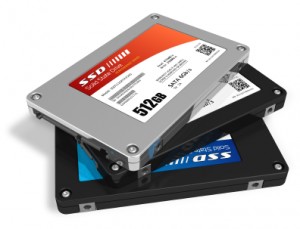Since the first solid state drive entered the market more than 35 years ago, there has been much debate about the pros and cons of this storage technology. We’ll take a look at these below.
Fact: Solid state refers to the electronic circuitry that is entirely built of semiconductors.
A SSD differs from that of a hard disk drive (HDD) due to the fact that solid state drives contain no moving parts. To understand why this is beneficial, we must look at how traditional HDDs function.
A hard disk stores data much like the way a floppy disk would. An actuator arm stretches over the platter and imprints magnetic pulses on the surface by a read/write head, which can also then read the data back. On an average domestic drive, this arm can oscillate around 50 times per second.
With that being said, let’s take a look at the Pros of solid state drives:
- Solid State Drives has no moving parts: This is beneficial in many ways. SSDs use less power because there are no motors to have to draw power from and all of its data is stored in memory chips. As previously mentioned, HDDs use drive motors to spin up the magnetic platters and drive heads. Some HDDs spin as high as 7200 RPMs or 67 MPH on its outer edge. This affects battery life, temperature and endurance. The absence of moving parts also eliminates the vibration and noise that occurs with HDDs.
- Solid State Drives enable faster data access & start up speed: Since SSDs don’t have to spin up the drive platters or move drive heads, the data can be read near instantly. The typical SSD boots up in about 15 seconds, whereas a traditional HDD can take up to one full minute or more to boot up.
- Solid State Drives are pretty tough: HDDs are quite fragile and are made of sensitive materials and even jarring movements can render a disk unreadable. SSDs have also been known to handle extremely cold and hot temperatures quite well and have withstood significant amounts of shock and force.
There are also some drawbacks to SSDs:
- SSDs tend to wear out: The individual bits can’t be erased and written to again after a while. Flash memory has a limited number of times that data can be written to a location.
- SSDs are expensive: The price per gigabyte is significantly more expensive than traditional drives. For example, a 2TB HDD costs around $100, which is exactly how much a 60GB SSD costs. You get way more storage for your buck with an HDD. SSDs are more expensive to produce, so the MSRP tends to be higher than that of HDDs.
- SSD has lower storage capacity: Compared to HDDs, SSDs have much less storage capacity. SSDs have not been made in high capacities yet. So, you will probably have to spend more money for more storage.
So, with that being said which type of drive do you prefer?